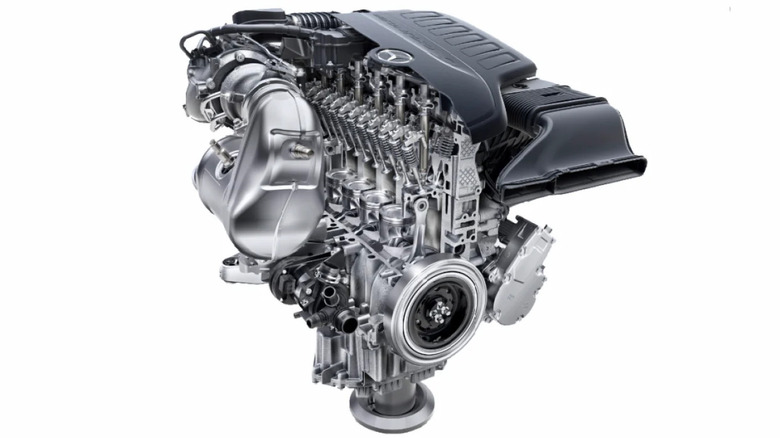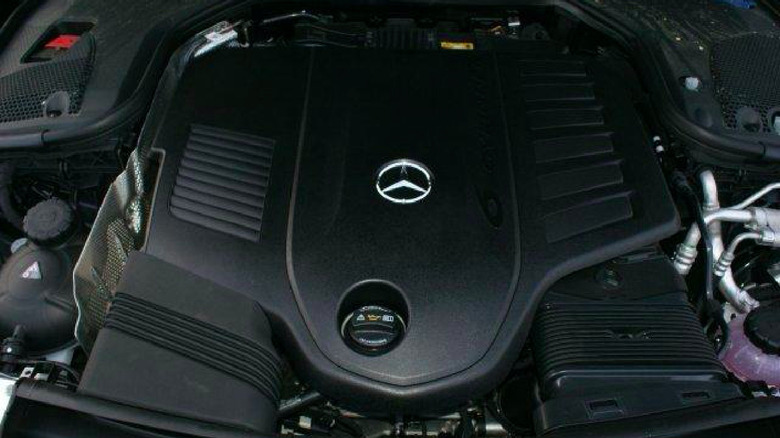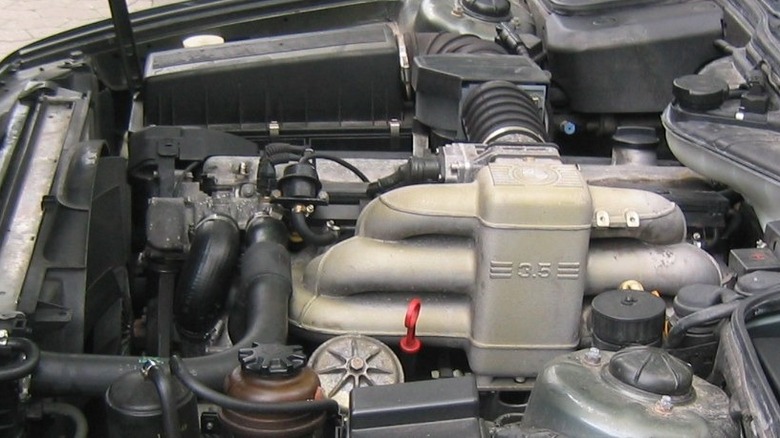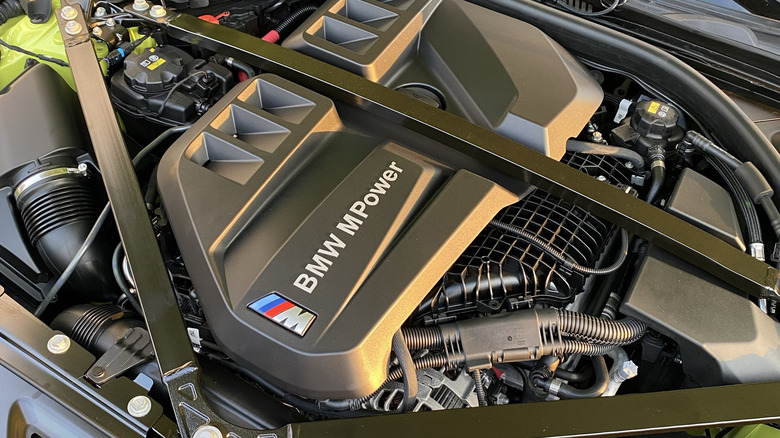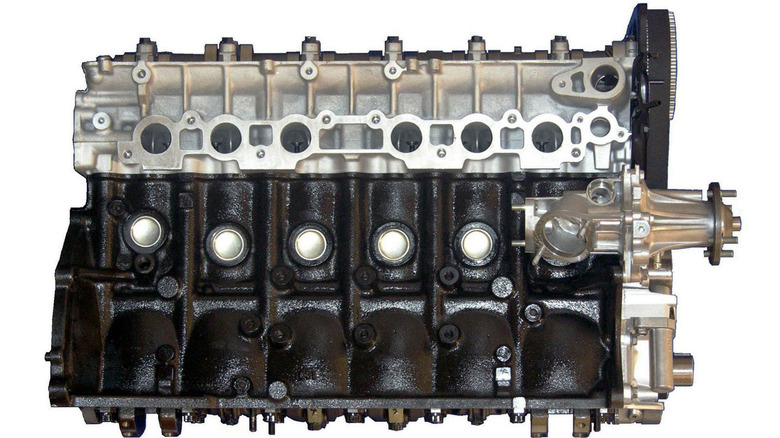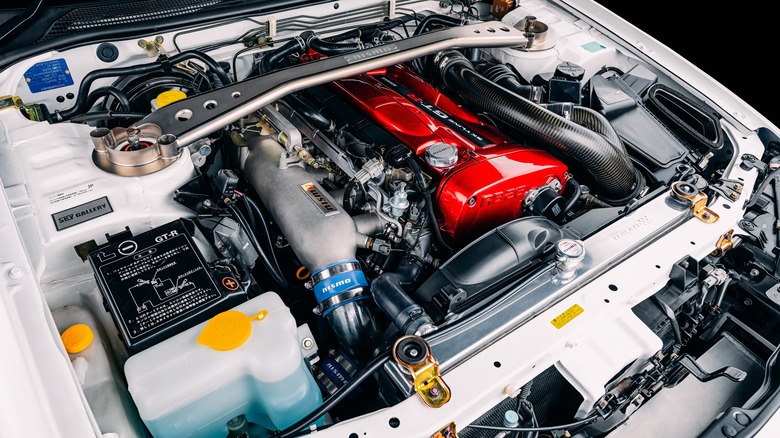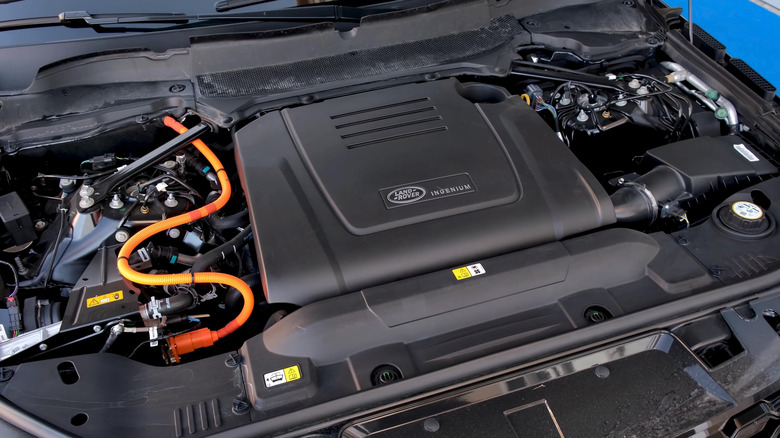6 Of The Most Powerful Inline-6 Engines Ever Put In Production Cars
When Carl Benz built what is regarded as the world's first car, the Patent Motorwagen, he powered it with a single-cylinder engine that produced less than one horsepower. More than a century's worth of evolution since then has brought us monsters like the nearly 1,000-horsepower marvel that is the Bugatti W16. Most engines fall somewhere between those two extremes, with four, six, and eight-cylinder configurations being the most common.
V8 engines powered many of the muscle cars of the 1960s and early '70s, and V6s are often used when economy is prized over raw horsepower. V6 engines tend to be harder to work on and less reliable than straight six engines, but are used more often because they can be easily swapped among a carmaker's various offerings and share space on an option sheet with I4s and V8s. Although inline-six engines like the legendary Jeep 4.0 are known for their dependability and smooth operation, we've seen more than a couple of powerful inline-six engines make their way into production vehicles. Here are a few of the most potent motors used in cars and SUVs that you could drive off a dealership's lot.
Mercedes M256 - 429 horsepower
Since the late 19th Century, Mercedes-Benz has been at the cutting edge of automotive technology, bringing innovations like the honeycomb radiator, independent suspension, and lifesaving crumple zone architecture. The Mercedes engine team was never far behind, utilizing superchargers for extra power as early as 1921. Mercedes built its first inline-six-cylinder engine three years later, but shelved the format temporarily in 1999, two years after it introduced the M112 V6.
Mercedes went back to its roots about two decades later with the M256: A turbocharged 3.0-liter inline-six that also had an electric supercharger on AMG models. The M256 was first used in European market 2018 S-class models, and debuted in the United States in the 2019 CLS, AMG E53, and AMG GT-53. The supercharged versions produced 429 horsepower and 384 pound-feet of torque, and the non-AMG version made 362 horsepower.
The M256 had a combination starter/alternator mounted at the front end of the crankshaft that ran on 48 volt power, and produced 20 horsepower and 162 pound-feet of torque. This high-voltage component allowed Mercedes' engineers to use smaller gauge wiring throughout the engine compartment, saving bulk and weight. The starter/alternator's 0.9 kilowatt-hour lithium-ion battery was recharged during braking and sprung to life quickly when the driver began moving from an idle stop. It also allowed for the elimination of belt-driven accessories, so Mercedes used a 48-volt air conditioning compressor and water pump.
BMW M30B35 - 208 horsepower
BMW'S M30 series of inline-six-cylinder engines enjoyed a 27-year run from 1968 through 1995, but the first iterations of that motor displaced either 2.5 or 2.8 liters, and only produced between 150 and 170 horsepower. By the late 1980s, the M30 had grown to 3.5 liters and could produce 208 horsepower and 225 pound-feet of torque. That engine, the M30B35, was first used in the 1987 E34 series 535i, where it stayed through 1992.
In 1988 and 1989, the M30B35 was installed in the 635CSi, and from 1989 through 1992, it was also found under the hood of the 735i. It was also sold to Italian manufacturer Rayton Fissore for use in the Magnum 3.5 SUV in 1988 and 1989. The M30 served as the foundation for the M88 racing-spec inline-six. That motor produced 277 horsepower and 243 pound-feet of torque in the M1, which saw production of only 453 units from 1978 through 1981.
BMW S58 - 500+ horsepower
BMW maintained its commitment to the inline-six engine well into the 21st Century, adding enhancements like turbochargers, variable valve timing, and direct fuel injection. In 2015, BMW unveiled the B58: a 3.0-liter I6 that produced as much as 382 horsepower. Four years later, a high-performance version of that engine labeled the S58 was released.
The S58 had a second turbocharger, three radiators, and dedicated cooling units for engine and transmission oils. A 503-horsepower version of the S58 first appeared in 2020 X3M and X4M crossovers, and a 543-horsepower version was used in the 2023 M4 CSL. SlashGear's Steven Ewing tested the M4 CSL, calling it "brutally good." With a limited global run of about 1,000 units and a race-oriented construction featuring plenty of carbon fiber, the CSL stretches the definition of a "production car," though. The more mainstream, but no less impressive M3 Competition xDrive and sedan models get 503 horsepower versions of the S58 that enable 0-60 times of 3.8 and 3.4 seconds, respectively.
Toyota 2JZ-GTE - 320 horsepower
German manufacturers don't have a monopoly on high-potency inline-six engines. Toyota has an impressive racing pedigree that has bled into the development of some beastly production powerplants, including the 2JZ-GTE turbocharged 3.0-liter inline-six. That engine debuted in 1991 in the Aristo, which was the Japanese market version of the Lexus GS300 luxury sedan. The 2JZ-GTE then came to the United States under the hood of the 1993-98 Supra.
Its naturally-aspirated 2JZ-GE predecessor produced up to 230 horsepower, but the turbocharged GTE was able to make as much as 320 horses in stock form. The 2JZ-GTE is as sturdy as it is powerful, thanks to a closed-deck cast iron block, forged steel crankshaft, and oil injection points underneath the pistons. The 2JZ-GTE's rock-solid build makes it immensely popular as a base engine for upgrades, like high-capacity fuel pumps, injectors, and aftermarket ECUs. These tweaks can make the 2JZ-GTE capable of more than 700 horsepower, and improvements to engine internals and the valve system can boost output to an unholy 2,000 horsepower in certain builds.
Nissan RB26DETT - 276 horsepower
Toyota isn't the only Japanese automaker to produce a high-performance inline-six for the masses. In 1989, Nissan resurrected the Skyline GT-R, gracing the new R32 model with all-wheel drive and a twin-turbo 2.6 liter straight-six engine. The engine's designation — RB26DETT — was a mouthful in itself, but was short for Response Balance DOHC (dual overhead cam) Electronic Twin Turbo.
In stock form, the RB26DETT produced 276 horsepower, in keeping with an agreement among Japanese manufacturers to limit performance for safety's sake. Removing the boost restrictor and tweaking the engine computer could get that number past 300 horsepower, though. The racing-spec Nismo version that soon followed was capable of almost twice that thanks to thicker cylinder walls and beefed-up internals. RB26-powered Nismos won all 29 Japanese Touring Car Championship races between 1989 and 1993, and a GT-R won the 1991 endurance race at Spa-Francorchamps in Belgium by over 20 laps.
The RB26DETT stayed in the street version of the Skyline through generational updates in 1995 and 1999 — although the R34 that debuted that year got upgraded turbochargers and a dual-mass flywheel. Like Toyota's 2JZ-GTE, the RB26DETT is highly tunable thanks to its sturdy build and impeccable balance. Diligent modders have been able to extract more than 1,000 horsepower from this legend.
Land Rover P400 - 395 horsepower
Powerful straight-six engines aren't just the domain of German luxury carmakers and performance-oriented Japanese cars. For the 2020 model year, Land Rover dropped a new 3.0-liter straight-six in the Defender that produced 395 horsepower and 406 pound-feet of torque. It was tagged the P400, and featured a mild hybrid motor that fed juice to the electric supercharger, but didn't contribute to the engine's output.
The P400 has stuck around in the Defender through the 2024 model year, with the same output numbers and a reputation for providing zippy performance to an SUV that weighs more than 5,000 pounds when empty. The P400 features an intercooled turbocharger and Gasoline Direct Injection, which helped the 2022 Defender get from 0-60 in 5.7 seconds. In his review of the 2023 Defender 110, SlashGear's Chris Davies reported that the P400 provided 8,201 pounds of towing capacity, while still delivering almost 18 miles per gallon of fuel efficiency in mixed driving.
